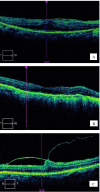Importance of optical coherence tomography before cataract surgery
- PMID: 39135029
- PMCID: PMC11320843
- DOI: 10.1186/s12886-024-03622-3
Importance of optical coherence tomography before cataract surgery
Abstract
Purpose: To determine the importance of optical coherence tomography (OCT) in patients scheduled for cataract surgery who present with no pathologies in biomicroscopic fundus examination.
Design: Retrospective study.
Methods: In this study, the routine ophthalmologic examination of patients who were recommended cataract surgery was performed.Occult retinal pathologies were evaluated using OCT in patients without any pathologies in biomicroscopic fundus examination.According to whether retinal pathologies were detected on OCT, the patients were divided into two groups: normal and abnormal OCT.The findings of patients with retinal pathologies on OCT and their distribution according to age were also evaluated.
Results: A total of 271 eyes from 271 patients were evaluated.The number of patients with retinal pathologies on OCT despite normal fundoscopic examination findings was 38(14.0%).Of these patients,15(39.4%) had an epiretinal membrane,10(26.3%) had age-related macular degeneration, eight(21%) had vitreomacular traction, two(5.2%) had a lamellar hole, and 1(2.6%) patient each had a full-thickness macular hole, an intraretinal cyst, and photoreceptor layer damage.The age distribution of the patients with retinal pathologies was as follows: two patients,<60 years; six patients,60-70 years;14 patients,70-80 years; and 16 patients,>80 years.The rate of patients aged > 70 years and above was 78.9%.There was no statistically significant difference between the normal and abnormal OCT groups in terms of age, gender, the presence of systemic diseases, visual acuity, central macular thickness, and cataract type or density(p > 0.05 for all).
Conclusion: In one of seven patients evaluated, retinal pathologies were detected on OCT despite normal fundoscopic examination findings.OCT can be used to detect occult retinal pathologies that cannot be detected by biomicroscopic fundus examination before cataract surgery.
Keywords: Cataract; Occult retinal pathology; Optical coherence tomography; Preoperative evaluation.
© 2024. The Author(s).
Conflict of interest statement
The authors declare that there are no conflicts of interest.
The authors declare no competing interests.
Figures
References
MeSH terms
LinkOut - more resources
Full Text Sources
Medical



